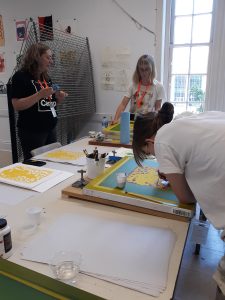Curious about Art Therapy?

Do you want to explore the possibilities or find out what you need to pursue a path to a degree in art therapy?
Art therapy is a mental health profession that enriches the lives of individuals, families, and communities through active art-making, creative process, applied psychological theory, and human experience within a psychotherapeutic relationship. —The American Art Therapy Association (AATA)
UA Art and Art History can provide the undergraduate coursework you’ll need to enter a master’s degree program in art therapy, which is the required entry level into art therapy work, according to the ACATE (Accreditation Council for Art Therapy Education). We have several options for preparatory studies.
You might be closer than you think!
One of the best ways to prepare to enter a master’s level program to train as an art therapist is to major in studio art and minor in psychology or double major in both subjects. You can earn a BA in studio art (with 42 hours) or a BFA in studio art (with 81 hours). You’ll get a strong background in all areas of studio art and psychology, be able to prepare a portfolio of your artwork for graduate school and gather experience through practicums, research, volunteering or other opportunities.
For a psychology minor you’ll need to take Psychology 101 plus six hours in 300- or 400-level courses, and then nine hours of psychology electives. Course topics that art therapy graduate programs like to see can be abnormal psychology, developmental psychology (including courses such as child psych, adult psych, lifespan or the psychology of aging); in some cases, a psych research class, statistics, or personality theory may also be preferred by a graduate school.
Some of the top master’s in art therapy programs include schools such as Florida State University, George Washington University, New York University and Indiana University-Purdue University Indiana.

If you’re thinking about majoring in art or are already an art major, then you’re almost there. Contact your adviser or our departmental office and we’ll talk you through your next steps, whether you need to declare a major or a minor or assess which courses you need.